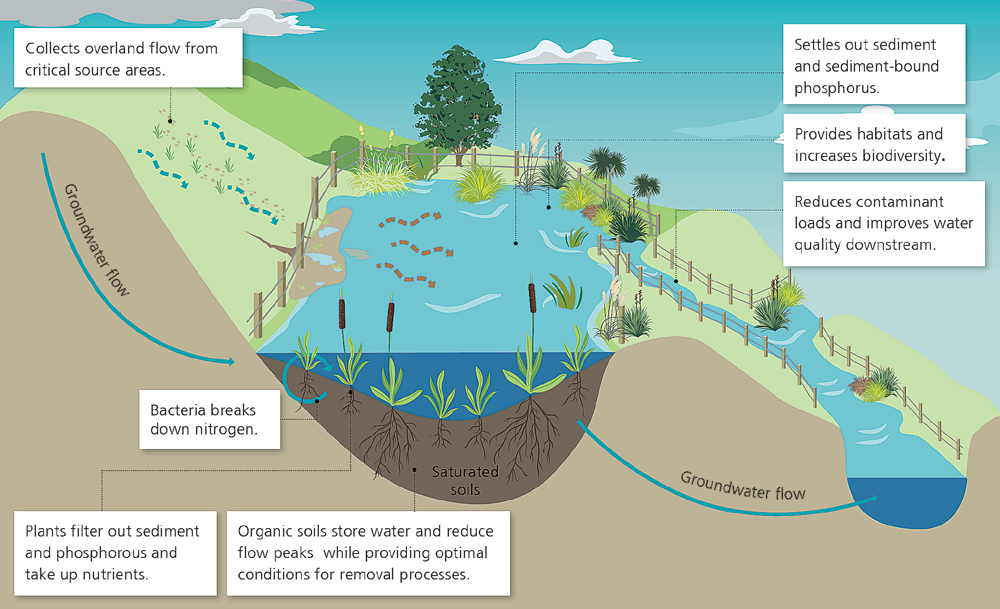$52,500 fine for effluent mismanagement
A Taupiri farming company has been convicted and fined $52,500 in the Hamilton District Court for the unlawful discharge of dairy effluent into the environment.
In managing contaminants on your farm, part of the solution might be right under your nose. DairyNZ environment manager Dr David Burger explains.
Bogs, swamps and seeps: these permanent or seasonally wet areas can all be classed as wetlands.
Historically, farmers have drained these wet areas to make their farms more productive but we now know that wetlands can play an important part in reducing our environmental footprint. In short, the benefits of protecting wetlands can outweigh those of gaining extra grazing space.
How wetlands work
Throughout New Zealand, wetlands support the greatest concentration of plants of any natural habitat. They help reduce flooding by acting as a sponge and improve water quality by trapping, filtering and removing contaminants, especially sediment, nitrogen and phosphorus. Protecting, restoring and creating these wetland ecosystems onfarm helps improve downstream water quality.
What is a wetland?
The three most common wetland types on dairy farms are seeps, wet or boggy places in paddocks, and wet areas beside riparian margins. You can recognise them by their location; they are easy to spot when you know what to look for.
Seeps occur at the bottom of hill slopes where groundwater comes to the surface. Seeps can be permanent or seasonal and exist on all soil types.
Wet areas in paddocks are swampy or boggy places where drainage is poor, such as hollows or valley bottoms. These areas could be fed by rainfall or a high water table, and tend to be on heavier soils.
Riparian wetlands are wet or boggy places bordering a waterway.
Whichever kind of wetlands you’re dealing with, managing them more effectively can offer animal welfare benefits and reduce the risk of stock getting stuck. Many farmers find the most satisfying part of managing wetlands is the resulting natural beauty and increase in biodiversity onfarm, particularly birdlife but also native fish and aquatic insects. 
How to manage a wetland
In looking after wetlands, your aim should be to get them to a stage where they can look after themselves with little input from you.
The steps to achieve this are the same for all three wetland types:
Make a plan by using DairyNZ’s Riparian Planner at dairynz.co.nz/riparian-planner.
Keep stock out by fencing.
Don’t drain wetlands; instead ensure their natural hydrology is maintained.
Identify weed and animal pests and control as appropriate.
Plant natives to suppress weeds and to increase biodiversity.
Take advice and keep it legal
If you want to restore or protect a wetland and it involves moving dirt or damming water, you may need consent. Always contact your local regional council or rural professional for advice and assistance. They can help you prepare a wetland management plan, identify potential funding and ensure your plans comply with the regional plan. Several years of weed and pest control may be required, so having a good maintenance plan is essential.
Find out more
For help creating a riparian management plan to fence, plant and protect your waterways, go to dairynz.co.nz/riparian-planner.
To learn more about wetlands in general, visit dairynz.co.nz/wetlands.
For more than 50 years, Waireka Research Station at New Plymouth has been a hub for globally important trials of fungicides, insecticides and herbicides, carried out on 16ha of orderly flat plots hedged for protection against the strong winds that sweep in from New Zealand’s west coast.
There's a special sort of energy at the East Coast Farming Expo, especially when it comes to youth.
OPINION: The latest reforms of local government should come as no surprise.
The avocado industry is facing an extremely challenging season with all parts of the supply chain, especially growers, being warned to prepare for any eventuality.
Rural recycling scheme Agrecovery is welcoming the Government's approval of regulations for a nationwide rural recycling scheme for agrichemicals and farm plastics.
Despite a late and unfavourable start, this year’s strawberry crop is expected to be bountiful for producer and consumer alike.
OPINION: Dipping global dairy prices have already resulted in Irish farmers facing a price cut from processors.
OPINION: Are the heydays of soaring global demand for butter over?